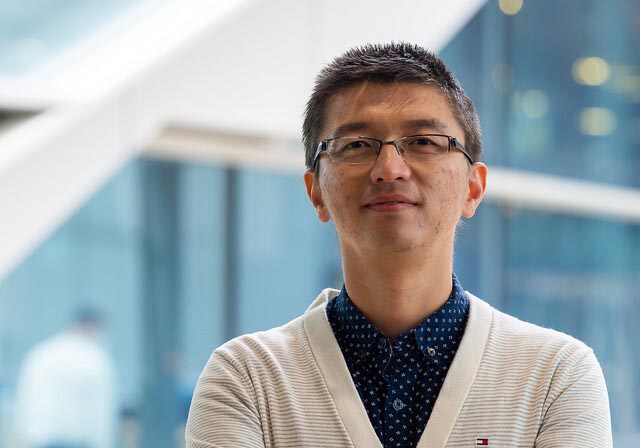
Larry Cheng, Dorothy Quiggle Career Professor in the Department of Engineering Science and Mechanics, plans to develop a skin graft that doubles as a wound monitoring device with a new $619,556 grant. IMAGE: PENN STATE COLLEGE OF ENGINEERING
Engineer receives Trailblazer grant to create smart skin grafts
11/1/2021
By Gabrielle Stewart
UNIVERSITY PARK, Pa. — Nearly 35 million people in the United States with diabetes face a common effect of dysregulated glucose: chronic, slow-healing wounds. Such wounds can lead to decreased quality of life, amputations and life-threatening infections. Foot wounds can be particularly challenging to monitor and treat because they typically require a total-coverage cast surrounding the whole foot and calf, and cast removal is necessary for wound evaluation.
Penn State and Mount Nittany Health researchers plan to develop a smart skin graft that can both improve the monitoring process and expedite healing in chronic wounds. Huanyu “Larry” Cheng, Dorothy Quiggle Career Professor in Penn State’s Department of Engineering Science and Mechanics, received a $619,556, three-year Trailblazer award from the National Institute of Biomedical Imaging and Bioengineering to lead the project.
“Foot ulcers can take months to years to heal,” Cheng said. “If we can achieve early wound monitoring and prevent complications in the beginning, the healing process is better off.”
Cheng and his research team aim to develop a device that offers the same healing benefits of a traditional skin graft — where healthy skin is used to cover damaged tissue — while also allowing for wound assessment without removal of a covering. Using zinc, a biodegradable element that could eventually absorb into the body, the researchers will fabricate temperature and moisture sensors to be placed on a similarly biodegradable hydrogel base layer that will serve as the skin graft.
Moisture and temperature are good indicators of wound healing status and critical for understanding the next treatment steps for patients and providers, according to Cheng. Sufficient moisture in a wound promotes restoration of blood flow, but too much can lead to infection. Temperature can also indicate this risk: the warmer the skin, the higher the likelihood for infection.
To combat infection and promote healing, the researchers also plan to mimic the small electrical field most wounds generate to prompt cells to migrate toward the injury while also discouraging bacteria growth, Cheng said. These migrating cells in typical wounds allow for blood vessel regrowth, nutrient transport and protein development, but chronic wounds tend to lack the electric field that encourages such healing.
With this research, Cheng said he aims to enable more accurate and convenient monitoring to help wounds heal quicker.
“Optical inspection of a wound requires the cast to be removed and can be subjective,” he said. “With sensors we will be able to quantitatively measure wound status information and use it to adapt wound healing practices.”
Co-principal investigators on this project include Jian Yang, professor of biomedical engineering and Dorothy Foehr Huck and J. Lloyd Huck Chair in Regenerative Engineering; Dino Ravnic, associate professor of surgery at the Penn State College of Medicine; David Craft, associate professor of pathology and laboratory medicine at the College of Medicine; and Jan S. Ulbrecht, endocrinologist at Mount Nittany Medical Center.



